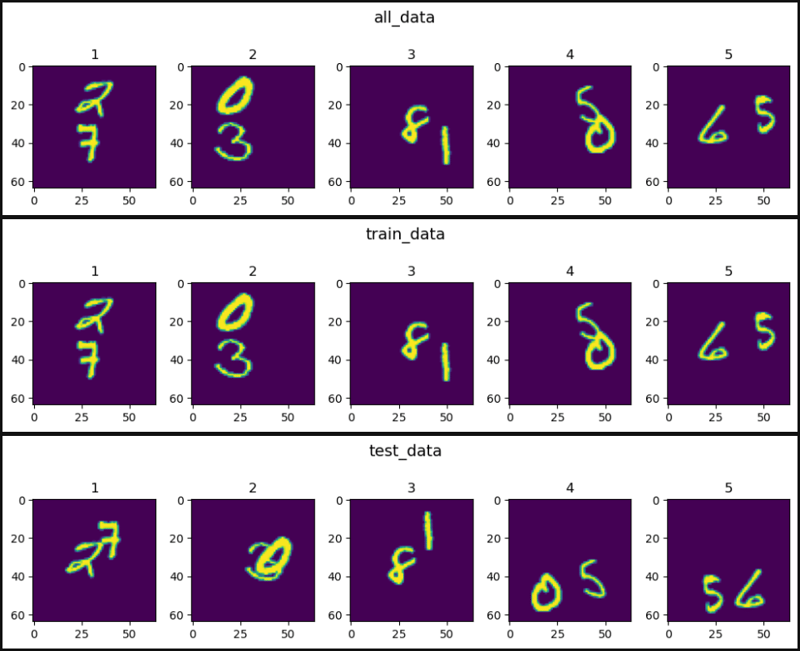
Buy Me a Coffee☕
*My post explains Moving MNIST.
MovingMNIST() can use Moving MNIST dataset as shown below:
*Memos:
from torchvision.datasets import MovingMNIST
all_data = MovingMNIST(
root="data"
)
all_data = MovingMNIST(
root="data",
split=None,
split_ratio=10,
download=False,
transform=None
)
train_data = MovingMNIST(
root="data",
split="train"
)
test_data = MovingMNIST(
root="data",
split="test"
)
len(all_data), len(train_data), len(test_data)
# (10000, 10000, 10000)
len(all_data[0]), len(train_data[0]), len(test_data[0])
# (20, 10, 10)
all_data
# Dataset MovingMNIST
# Number of datapoints: 10000
# Root location: data
all_data.root
# 'data'
print(all_data.split)
# None
all_data.split_ratio
# 10
all_data.download
# <bound method MovingMNIST.download of Dataset MovingMNIST
# Number of datapoints: 10000
# Root location: data>
print(all_data.transform)
# None
from torchvision.datasets import MovingMNIST
import matplotlib.pyplot as plt
plt.figure(figsize=(10, 3))
plt.subplot(1, 3, 1)
plt.title("all_data")
plt.imshow(all_data[0].squeeze()[0])
plt.subplot(1, 3, 2)
plt.title("train_data")
plt.imshow(train_data[0].squeeze()[0])
plt.subplot(1, 3, 3)
plt.title("test_data")
plt.imshow(test_data[0].squeeze()[0])
plt.show()

from torchvision.datasets import MovingMNIST
all_data = MovingMNIST(
root="data",
split=None
)
train_data = MovingMNIST(
root="data",
split="train"
)
test_data = MovingMNIST(
root="data",
split="test"
)
def show_images(data, main_title=None):
plt.figure(figsize=(10, 8))
plt.suptitle(t=main_title, y=1.0, fontsize=14)
for i, image in enumerate(data, start=1):
plt.subplot(4, 5, i)
plt.tight_layout(pad=1.0)
plt.title(i)
plt.imshow(image)
plt.show()
show_images(data=all_data[0].squeeze(), main_title="all_data")
show_images(data=train_data[0].squeeze(), main_title="train_data")
show_images(data=test_data[0].squeeze(), main_title="test_data")



from torchvision.datasets import MovingMNIST
all_data = MovingMNIST(
root="data",
split=None
)
train_data = MovingMNIST(
root="data",
split="train"
)
test_data = MovingMNIST(
root="data",
split="test"
)
import matplotlib.pyplot as plt
def show_images(data, main_title=None):
plt.figure(figsize=(10, 8))
plt.suptitle(t=main_title, y=1.0, fontsize=14)
col = 5
for i, image in enumerate(data, start=1):
plt.subplot(4, 5, i)
plt.tight_layout(pad=1.0)
plt.title(i)
plt.imshow(image.squeeze()[0])
if i == col:
break
plt.show()
show_images(data=all_data, main_title="all_data")
show_images(data=train_data, main_title="train_data")
show_images(data=test_data, main_title="test_data")

from torchvision.datasets import MovingMNIST
import matplotlib.animation as animation
all_data = MovingMNIST(
root="data"
)
import matplotlib.pyplot as plt
from IPython.display import HTML
figure, axis = plt.subplots()
# ↓ ↓ ↓ ↓ ↓ ↓ ↓ ↓ ↓ ↓ `ArtistAnimation()` ↓ ↓ ↓ ↓ ↓ ↓ ↓ ↓ ↓ ↓
images = []
for image in all_data[0].squeeze():
images.append([axis.imshow(image)])
ani = animation.ArtistAnimation(fig=figure, artists=images,
interval=100)
# ↑ ↑ ↑ ↑ ↑ ↑ ↑ ↑ ↑ ↑ `ArtistAnimation()` ↑ ↑ ↑ ↑ ↑ ↑ ↑ ↑ ↑ ↑
# ↓ ↓ ↓ ↓ ↓ ↓ ↓ ↓ ↓ `FuncAnimation()` ↓ ↓ ↓ ↓ ↓ ↓ ↓ ↓ ↓
# def animate(i):
# axis.imshow(all_data[0].squeeze()[i])
#
# ani = animation.FuncAnimation(fig=figure, func=animate,
# frames=20, interval=100)
# ↑ ↑ ↑ ↑ ↑ ↑ ↑ ↑ ↑ `FuncAnimation()` ↑ ↑ ↑ ↑ ↑ ↑ ↑ ↑ ↑
# ani.save('result.gif') # Save the animation as a `.gif` file
plt.ioff() # Hide a useless image
# ↓ ↓ ↓ ↓ ↓ ↓ ↓ ↓ Show animation ↓ ↓ ↓ ↓ ↓ ↓ ↓ ↓
HTML(ani.to_jshtml()) # Animation operator
# HTML(ani.to_html5_video()) # Animation video
# ↑ ↑ ↑ ↑ ↑ ↑ ↑ ↑ Show animation ↑ ↑ ↑ ↑ ↑ ↑ ↑ ↑
# ↓ ↓ ↓ ↓ ↓ ↓ ↓ ↓ ↓ ↓ ↓ ↓ Show animation ↓ ↓ ↓ ↓ ↓ ↓ ↓ ↓ ↓ ↓ ↓ ↓
# plt.rcParams["animation.html"] = "jshtml" # Animation operator
# plt.rcParams["animation.html"] = "html5" # Animation video
# ↑ ↑ ↑ ↑ ↑ ↑ ↑ ↑ ↑ ↑ ↑ ↑ Show animation ↑ ↑ ↑ ↑ ↑ ↑ ↑ ↑ ↑ ↑ ↑ ↑


from torchvision.datasets import MovingMNIST
from ipywidgets import interact, IntSlider
all_data = MovingMNIST(
root="data"
)
import matplotlib.pyplot as plt
from IPython.display import HTML
def func(i):
plt.imshow(all_data[0].squeeze()[i])
interact(func, i=(0, 19, 1))
# interact(func, i=IntSlider(min=0, max=19, step=1, value=0))
# ↑ ↑ ↑ ↑ ↑ ↑ ↑ ↑ ↑ ↑ Set the start value ↑ ↑ ↑ ↑ ↑ ↑ ↑ ↑ ↑ ↑
plt.show()


The above is the detailed content of MovingMNIST in PyTorch. For more information, please follow other related articles on the PHP Chinese website!




